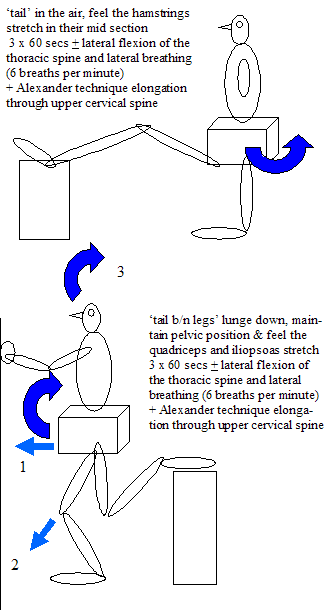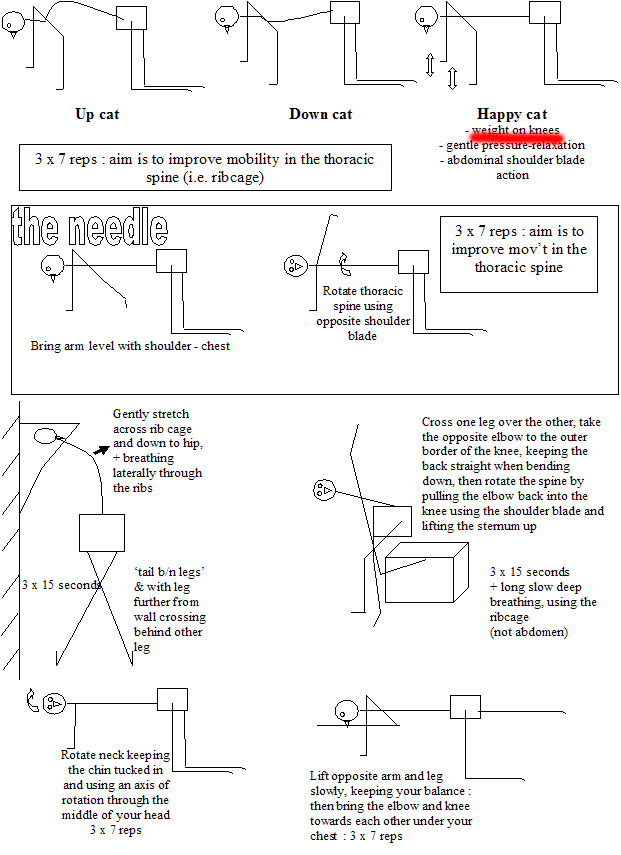Clinical presentation of an L5 Intervertebral Disc hernia causing severe arm symptoms
A young (33 year old) lady presented with severe left lateral elbow pain with anterior and posterior forearm pain which she described as deep muscular weakness, associated with shaking of the thumb and index finger. The symptoms commenced 1 week previously and was attributed to a 6 week period of 16 hour working days. 1 day prior to treatment some stiffness in the lower left cervico-thoracic junction occurred. Typing was limited to 15 minutes before the onset of severe muscular fatigue in the neck and arm which lasted for 1/2 a day. A past history of low back pain in 2000 was reported.
Initial examination revealed all movements in the cervical spine to be limited to approx. 3/4. However, on trying to assess upslopes and downslopes the client complained about having 2 pillows and preferred to have one thin pillow or none at all. Some spasms limited gliding movements in upslopes on the left at C2/3, C5/6 and C7/T1. Neurological S+S were unremarkable. Stiffness on palpation of the left mid thoracic spine (T4-T6) and right T6-9, R6-9 was encountered. Oerebro (ORMPQ) score was 70. Treatment was commenced on these cervical and thoracic segments although there was a sense of trepidation that the full picture hadn't revealed itself yet. The ROM's of the cervical spine were to be used as an immediate re-assessment guide and her ability to type would be used as the disability measure. ROM's of rotation had improved and MWM's of elevation/depression on the first rib improved side bending. However, flexion and extension were ISQ.
The client returned somewhat worse, complaining of a stiff neck after treatment. This client was receiving treatment (free-of-charge to her) under the NSW workers compensation scheme. It would have been easy to assume some 'yellow flag' issue yet her ORMPQ score did not vindicate such reasoning. Having not been convinced of my total understanding of the clinical picture, I decided to re-visit the old low back injury. The lumbar spine ROM's were left and right rotation 1/2, left and right lateral flexion 4/5, flexion 4/5 and extension 1/2. However, SLR with dorsiflexion and Passive Neck Flexion was limited to 30 degrees on the left, whereas it was 70 degrees on the right and unaltered with PNF.
Treatment was then directed at the lumbar and thoracic spine to address issues of adverse neural tension (ANT) and excessive force closure. Joint mobilisations in the form of L5/S1 rotation MET's and iliopsoas release was applied to improve the ROM of SLR. The mid-low thoracic region was mobilised and lateral breathing techniques were taught with an emphasis on iliopsoas relaxation and pelvic floor elevation. Exercises were designed to stretch the thoracic and lumbar spine into lateral flexion whilst placing the leg into either quadriceps stretch or modified hamstring stretch with the arm overhead for latissimus dorsi - forearm flexor stretch (see below). Additionally, the client was asked to elongate through the upper cervical spine and breath slowly and deeply through the sides. The 'happy cat' or 'prancing horse' was shown to improve intersegmental thoracic rotation as well as enhance scapula stability and improve superficial abdominal relaxation times. Work station ergonomics was also addressed and a McKenzie lumbar roll was supplied. Juggling exercises were introduced for global balancing. McKenzie extension exercise as well as supine unilateral rotation exercise for the lumbar spine was also shown. Dry needling techniques were used to release the excessive force closure from erector spinae activity in the lumbar and thoracic spines. The client was also encouraged to undertake some form of low load endurance exercise as this would improve overall blood flow as well as muscular stability.


The emphasis on the lumbar spine had immediate effects on it's movements as well as improve the ROM of SLR with DF and PNF. The ability to type has also improved dramatically. This was an interesting case of incompletely resolved pathology creating poor dynamics in another part of the spine, where extreme 'overuse' resulted in pain in the region which by nature of the activity was being overloaded the most. The unsatisfactory result during the re-assessment of signs and symptoms at the initial examination were the guiding factors in determining the need for further investigation and treatment. Finally, the almost full ROM of forward flexion of the L/S may seem dichotomous to the findings of limited SLR. However, on closer examination using the Susanne Klein Vogelbach methodology, it was revealed that the pelvis was translating posteriorly (w.r.t the room) thus taking the ankles out of DF. Furthermore, the foward flexion result of fingers to ankles reflected the clients long arms and a long thoracic torso where the flexion really was occuring. Hence detailed movement analysis is important in the examination process.
Return to Instructional Design
Uploaded : 15 August 2006

























































































































